
2023 was the year I began reviewing hardware for Windows Central in earnest, and it has been a busy debut for me. I've been sent so much hardware to check out that I've unfortunately not been able to get to everything in a reasonable amount of time. I regret that with the ASUS Zenbook 14X OLED more than any other device because this is genuinely one of the most fun laptops I have ever used. It has easily earned my recommendation and then some.
However, this review is going to be a shorter one for me because we're on the cusp of a new generation of mobile computing. Intel Ultra chipsets are coming, and companies like ASUS have already begun announcing their next lineup of ultra-portable, ultra-powerful Windows laptops boasting the next-gen CPUs. Even with Intel Ultra on the horizon, though, I still love the Zenbook 14X OLED and recommend that those who need a new laptop right now strongly consider it (and even when the new hardware arrives, this laptop could be a tempting value play).
Disclaimer: This review was made possible by a review unit provided by ASUS. The company did not see the contents of the review before publishing.
Zenbook 14X OLED review: Pricing and specifications
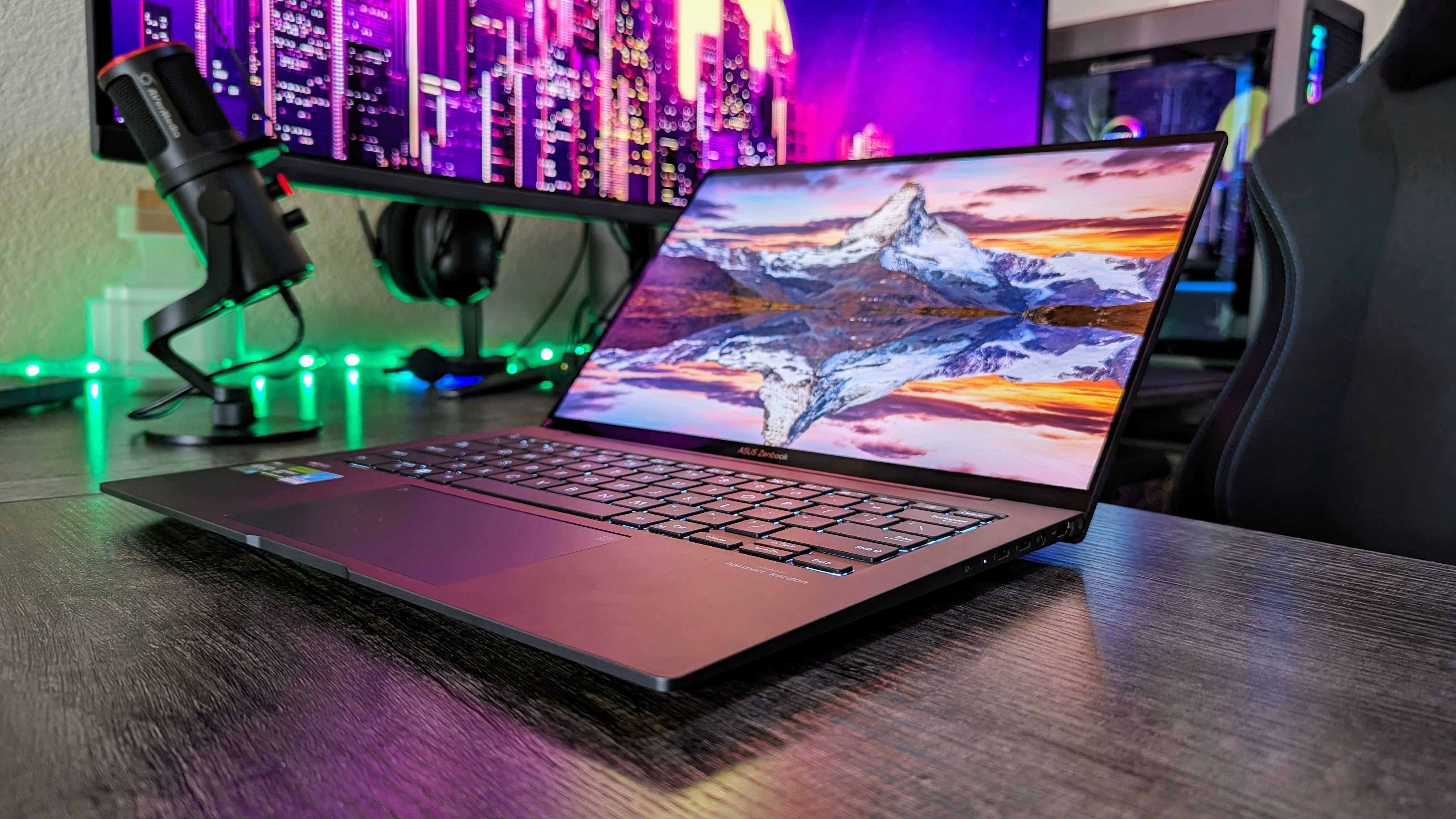
Pricing highlights
- The Zenbook 14X OLED comes in exactly one configuration, which has an MSRP of $1,499.99.
- For that price, you're getting a 13th Gen Intel Core i9 CPU, an NVIDIA GeForce RTX 3050 GPU, 32GB of LPDDR5 RAM, and 1TB of SSD storage.
- This laptop feels incredibly well priced even at full price, but it may see discounts as Intel Ultra hardware begins releasing.
• Price: $1,499.99 at Best Buy
• Display: 14.5-inch OLED, 16:10 2.8K (2880 x 1800), 60-120Hz refresh rate, 0.2ms response time, 550 nits max brightness, VESA DisplayHDR True Black 600 certified, PANTONE Validated, touch display, glossy, ASUS Pen 2.0 support
• CPU: Intel Core i9-13900H (14 cores, 20 threads, up to 5.4GHz)
• GPU: NVIDIA GeForce RTX 3050 w/ 4GB GDDR6 VRAM
• RAM: 32GB LPDDR5 @ 4,800MHz
• Storage: 1TB M.2 NVMe PCIe Gen 4x4 SSD
• Battery: 70WHr, 100W USB Type-C charger
• Ports: 1x USB Type-A 3.2 Gen 2, 2x USB Type-C Thunderbolt 4 w/ Power Delivery, 1x HDMI 2.1, 1x 3.5mm audio jack
• Other details: ASUS NumberPad, FHD front-facing camera w/ Windows Hello, stereo harmon/kardon speakers w/ Dolby Atmos, dual-microphones, Wi-Fi 6E (802.11ax Dual Band), Bluetooth 5.3, US MIL-STD 810H certified
• Dimensions: 321.8 x 225.6 x 16.9mm (12.67 x 8.88 x 0.67in)
• Weight: 1.56 kg (3.44 lbs)
ASUS does away with the stress of making a choice, as the Zenbook 14X OLED graces online storefronts in exactly one configuration right now. You get the "Inkwell Grey" colorway for that compact, metal-clad body (ASUS also shows a pale gold "Sandstone Beige" colorway on its website, but it doesn't appear to be available anymore), the headlining 14.5-inch, 2.8K, 120Hz OLED display, a 13th Gen Intel Core i9-13900H, an NVIDIA GeForce RTX 3050 GPU, a generous 32GB of LPDDR5 RAM, and 1TB of SSD storage.
There may only be one configuration remaining, but it's honestly packed with features and contained in a premium-feeling, well-rounded package, making the MSRP of $1,499.99 at Best Buy feel incredibly reasonable. You're getting a lot of laptop for that money, undercutting other premium alternatives from Dell, HP, and more. With a new generation of Intel processors right around the corner, too, we may see the ASUS Zenbook 14X OLED go on sale, making it an even more lucrative option for anyone needing a thin, light, and powerful 14-inch ultrabook.
Despite the inclusion of a discrete GPU, this laptop is even Intel Evo certified, guaranteeing this laptop means a minimum standard for battery life, wake-from-sleep responsiveness, wireless connectivity, and more. In the box, you get the ASUS Zenbook 14X OLED (UX3404), a USB Type-A to Ethernet (RJ45) adapter, the 100W USB Type-C charger, and even a carrying sleeve. The sleeve is about as basic as laptop sleeves come, but the material feels nice and high-quality, and there's an included pen loop should you choose to pick up the optional ASUS Pen 2.0 accessory for your new Zenbook. Laptop manufacturers including extras like sleeves in the box is becoming increasingly rare as it is, so I was honestly shocked to see it here.
Zenbook 14X OLED review: Design and build quality

Design highlights
- The Zenbook 14X OLED boasts an all-aluminum construction with tasteful design flourishes.
- The build quality feels awesome, and the layout of the keyboard, touchpad, and ports is smartly done.
- The "Inkwell Grey" colorway is a fingerprint magnet, though, slightly diminishing what is otherwise a very attractive laptop.
ASUS had never been my first thought for "beautifully designed Windows laptops" in the past, but the Zenbook 14X OLED reversed that tendency. Pulling it out of the box, I was immediately impressed by every angle of the design. This laptop is tightly constructed, everything is intelligently positioned, and it looks great. More than anything, though, the Zenbook 14X OLED just feels good to use. The all-aluminum body is pretty thin (16.9mm) and light (3.44lbs) for a laptop packing so much power, with a dense, reassuring feel in the hand backed by the US MIL-STD 810H certification ASUS earned after putting this laptop through 26 brutal standardized durability tests.
Opening the laptop with one hand shows off a smoothly actioned, stable hinge. The gorgeous OLED display (more on that in the next section) is framed by very thin bezels, the keyboard has a nice, spacious layout, and the glass touchpad is as large as you can expect on a 14-inch device. There's also a solid selection of ports here, with ASUS supporting the two USB Type-C Thunderbolt 4 ports (both with Power Delivery) with a USB Type-A 3.2 Gen 2 port, an HDMI 2.1 port, and a 3.5mm headphone jack. This laptop can accomplish quite a lot with those ports, and you even get a USB Type-A to Ethernet adapter in the box.
Honestly, I love the design of this laptop. It's a good mixture of soft curves and hard lines, the subtle pattern on the lid looks premium without drawing too much attention, and the overall fit and finish are top-notch. A little icing on the cake is the 180-degree hinge, which gives you a lot of flexibility. My only real complaint in this department is how this grey color easily shows smudges and fingerprints. The gold color apparently features a unique ceramic-like finish to combat this exact problem, so I'm sad that my preferred color (and the only one still available) still has to deal with all the smudges.
Zenbook 14X OLED review: Display

Display highlights
- The display is the headlining feature of the Zenbook 14X OLED, and it absolutely does not disappoint.
- It's sharp, smooth, vivid, and amazingly color-accurate, amounting to one of the best visual experiences of any laptop I've used.
- It boasts a ton of different brands and names like Lumina, VESA DisplayHDR True Black 600, PANTONE Validated, and more, but all you need to know is this display is wonderful.
OLED displays might be about to become a whole lot more common in laptops, but ASUS has been ahead of the curve. The Zenbook 14X OLED has a positively magnificent 14.5-inch 2.8K OLED panel situated between its "NanoEdge" bezels. From the moment you open this laptop, you're struck by the vibrant and bright colors, the peerless dynamic range, the depthless blacks... This is just a really, really good display, and it has the numbers to back it up, too.
This is a tall 16:10 aspect ratio (the best aspect ratio for laptops) with a very sharp 1800p resolution that looks immaculate at this size. That "Lumina" OLED panel (because companies have to name everything) claims over 100% of the sRGB color gamut and 100% of the DCI-P3 color gamut with a PANTONE Validation for color reproduction, boasts a peak brightness of up to 550 nits, aims to be an impressive HDR-capable display with VESA DisplayHDR True Black 600 certification (and Dolby Vision compatibility), and still manages to bake in a speedy 120Hz refresh rate and 0.2ms response time.
The Zenbook 14X has a glossy display instead of anti-glare, which is a little unfortunate, but the trade-off is no compromise in sharpness or color and touch and stylus capabilities. The 180-degree hinge will come in handy for that part, but this isn't a 2-in-1 convertible — just a good, old-fashioned clamshell with some impressive capabilities. If you do decide you want to touch pen to glass, the ASUS Pen 2.0 can be had for just $82.99 at Amazon.
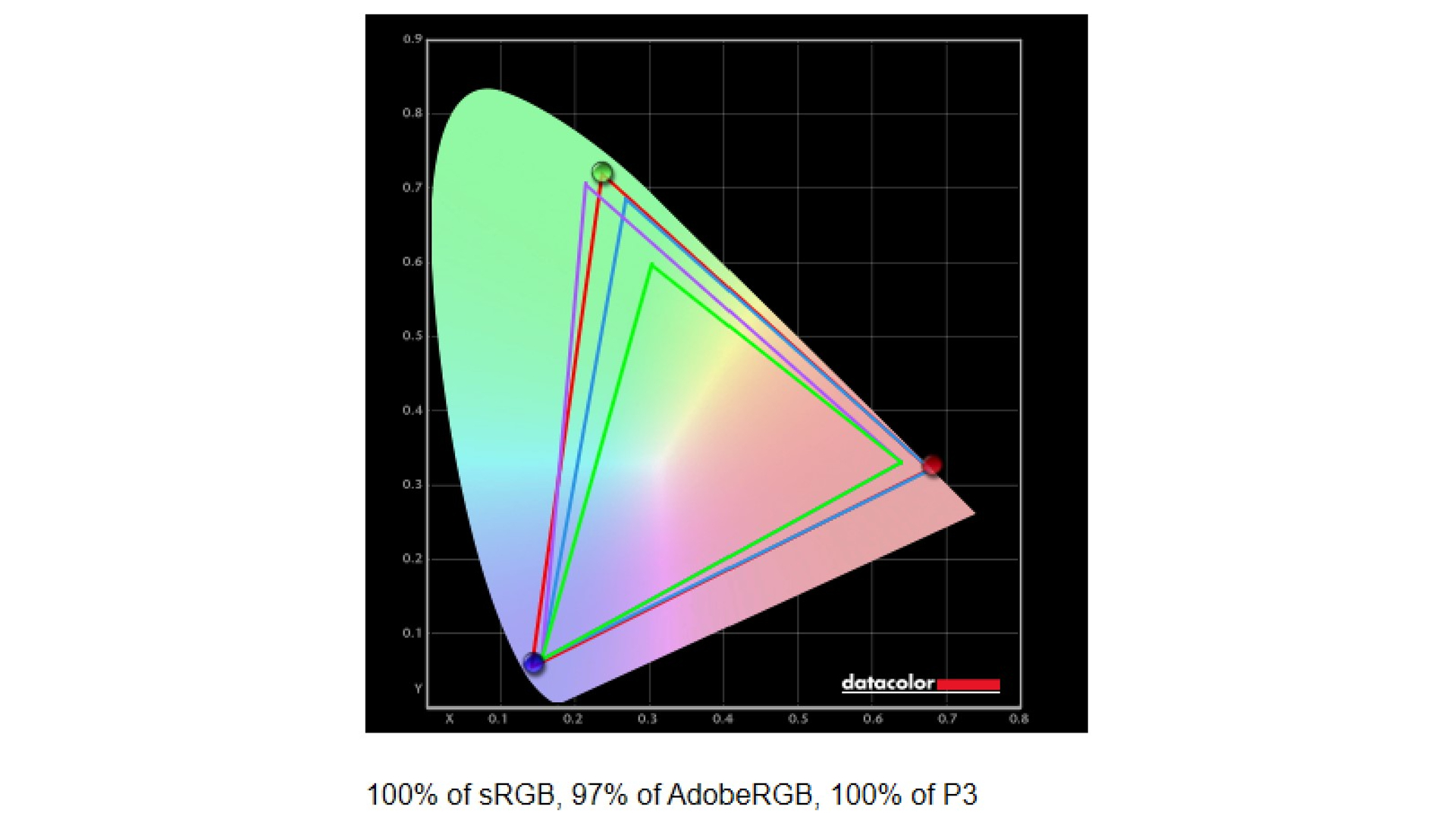


If we turn to the hard numbers, ASUS' boasts were no joke. In its Native color profile, this display easily hits 100% of both sRGB and DCI-P3, and there are separate profiles for each color gamut should you want to lean harder into one or the other. I personally preferred the Native color profile all around, as it just looks fantastic, no matter the content. Brightness in regular use doesn't quite reach the promised 400 nits in any setting (the highest I ever saw was 371 nits), but HDR content can push that brightness higher in small areas of the display at a time.
And HDR content does look phenomenal on the Zenbook 14X OLED. Perfect blacks and incredible contrast ratios are a match made in heaven for HDR content, and this display doesn't disappoint. A higher max brightness would no doubt make a more significant difference, but I'm willing to forgive that one small weakness.
A couple of small points before I move on: the display strangely adopts a considerably warmer tone only at the absolute lowest brightness level (I mean 0%, even 1% maintains the display's typical white balance), which is odd. Also, there's no variable refresh rate here. This display is either 120Hz all the time or 60Hz all the time, or you can jump between the two for when you're plugged in or running on battery power (but there's a brief black screen when it's switching). That's a little disappointing but something that can be improved in future iterations of this device.
Zenbook 14X OLED review: Performance and thermals

Performance highlights
- Despite its 14-inch chassis, the Zenbook 14X OLED still packs an Intel Core i9 and discrete NVIDIA GPU.
- Performance is impressive, with ASUS doing a fair job keeping these components cool under pressure.
- Other laptops (larger) can pull more out of these internals, but the Zenbook 14X OLED always felt fast and responsive.
In day-to-day usage, the Zenbook 14X OLED runs amazingly. It boots up quickly, launches apps instantly, multitasks effortlessly, and is able to ramp up in power immediately whenever you need it. This is a responsive, fast computer that felt far more performant than the HP Zbook 14" (G10), my previous top pick for a 14-inch laptop (that I've personally used).
ASUS also touts its "IceCool" thermal management system for keeping things cool, and while the name is silly, it does the trick. Cool air gets pulled in through the bottom intake event, and hot air is blown out of exhaust vents on the left side and rear of the laptop, keeping hot air off of you. These fans can get extremely loud, and the area above the keyboard can become hot to the touch, but the Zenbook 14X OLED continues to perform well. After a stress test of running 3DMark Time Spy 20 times nonstop, the Zenbook 14X OLED came out the other side with a 99% framerate stability. Outside of strenuous work, the Zenbook 14X OLED is perfectly cool and quiet.
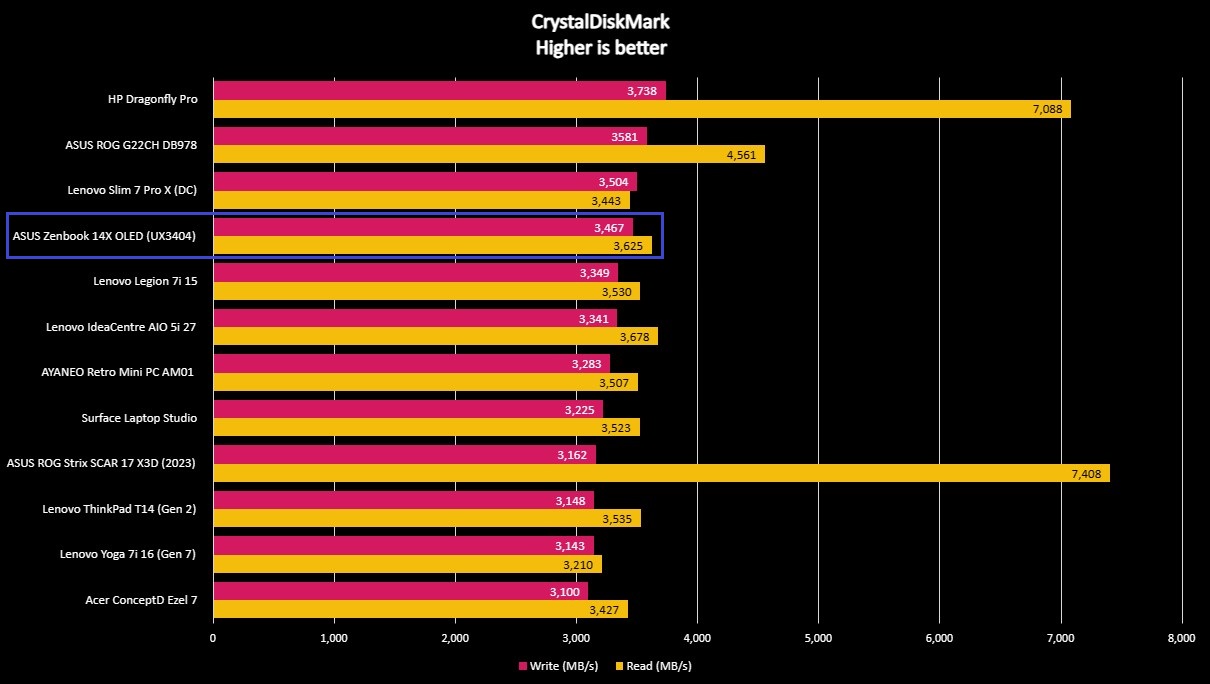
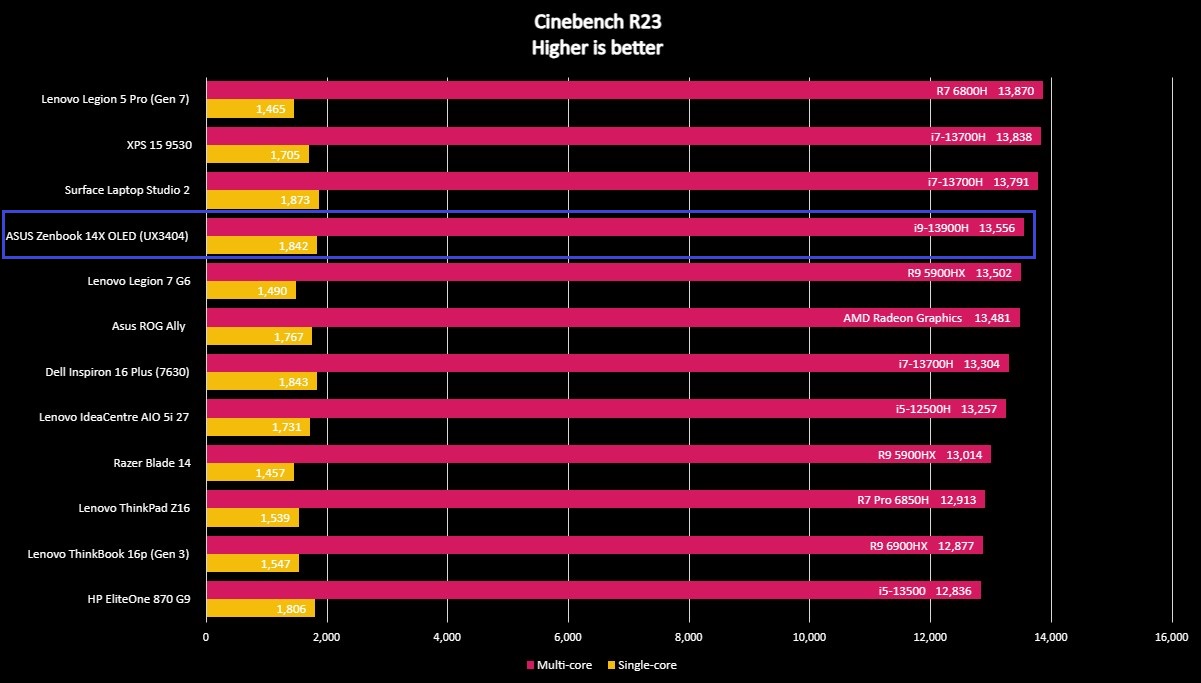



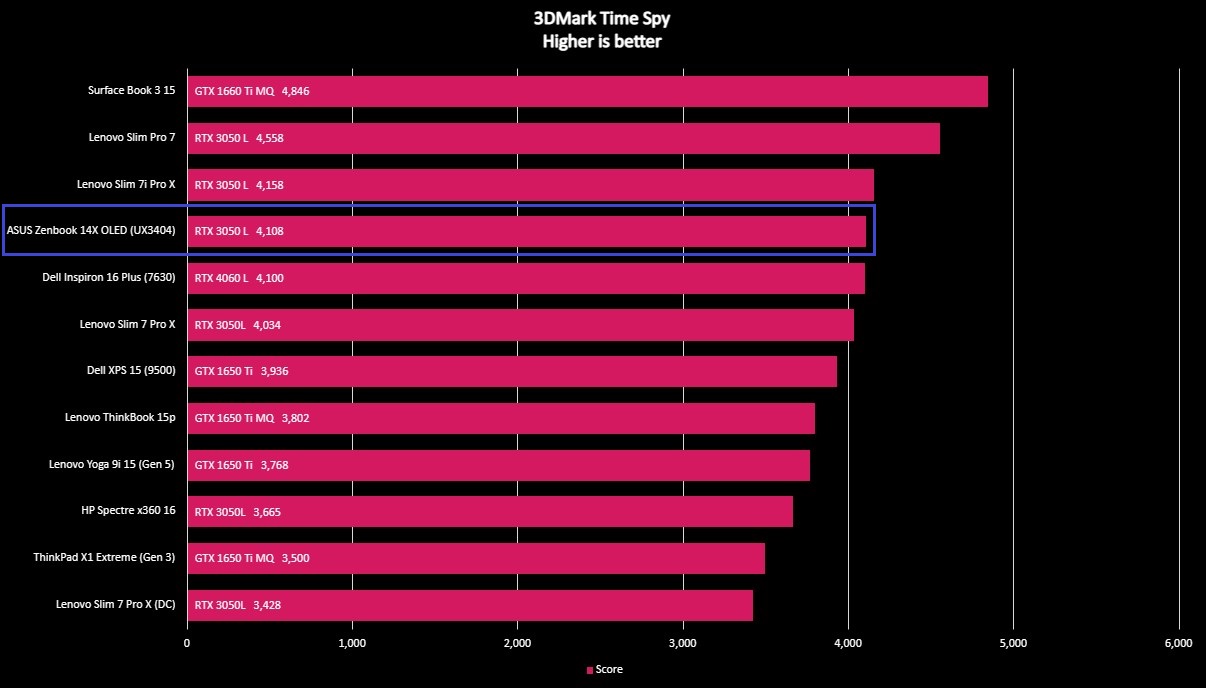
You can peruse the graphs above for more information on how the ASUS Zenbook 14X OLED (UX3404) compares to other Windows laptops we've tested. For the most part, this laptop does a great job competing with larger laptops with more room for superior thermal management systems... And those laptops often cost a lot more than this one does. PCMark 10's Modern Office benchmark is the only test where the Zenbook 14X OLED performed closer to other ultrabooks of similar sizes despite multiple tests. From my personal experience, though, this laptop is considerably faster than any ultrabook I've used with an Intel U-series chipset.
Of course, there's also the NVIDIA GeForce RTX 3050. ASUS positions this laptop more for creators than gamers, so this GPU is running on NVIDIA's Studio drivers instead of the more mainstream Game-Ready drivers. Despite that, the Zenbook 14X OLED is actually viable as a casual gaming machine. At an FHD+ (1200p) resolution and the Medium preset, I was able to achieve a stable 60+ FPS average in Counter-Strike 2, 82 FPS in Forza Horizon 5, and 76 FPS in Gears 5. This laptop won't play all of the latest and greatest PC games at the highest settings, but it can absolutely give you a boost when editing videos, 3D modeling, or any other GPU-related creative work and let you relax and play video games after the work day ends.
Zenbook 14X OLED review: Battery life
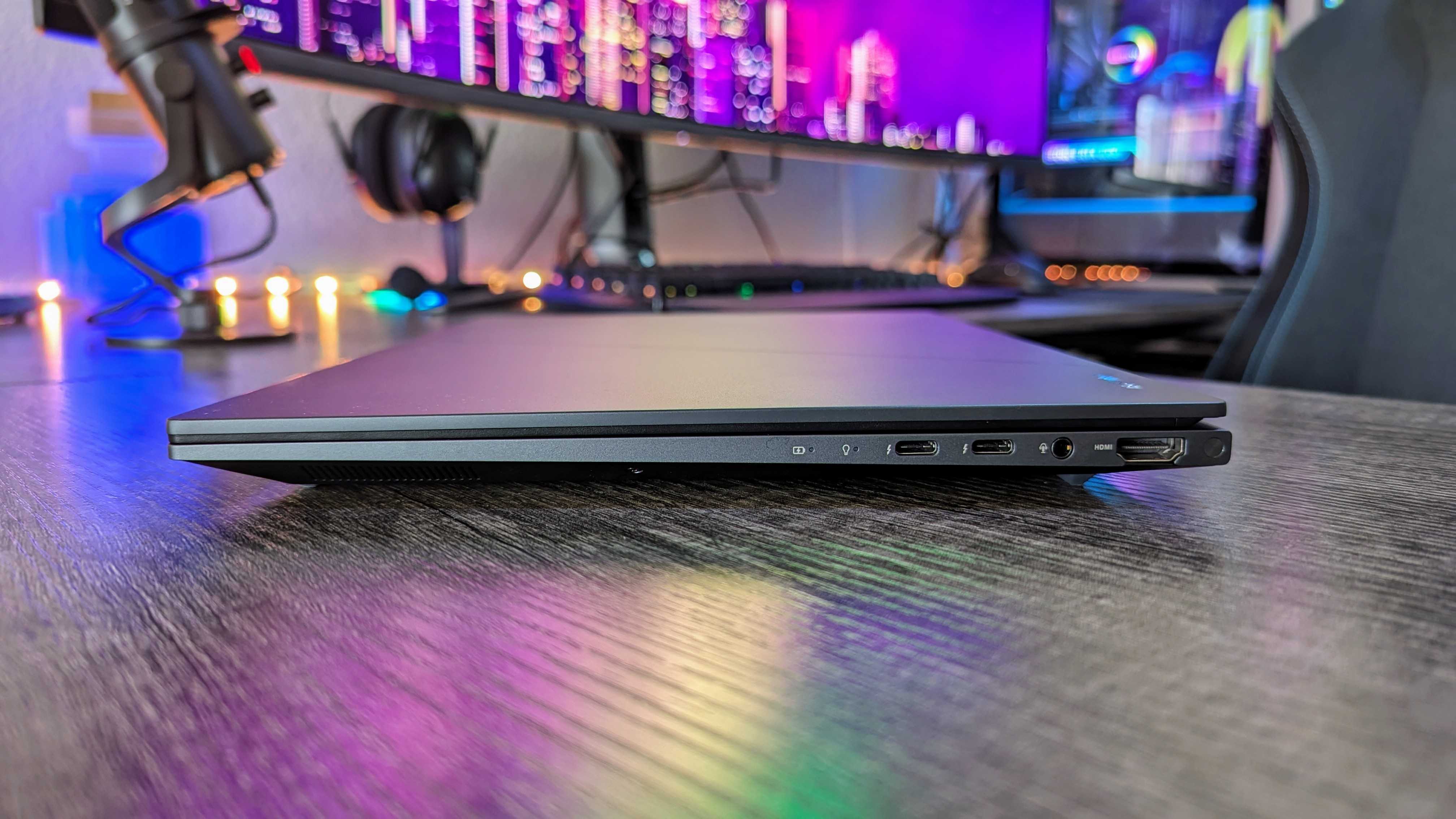
Battery highlights
- A 70WHr battery keeps things running, and a 100W USB Type-C charger lets you recharge.
- Despite a very powerful CPU and discrete GPU, the Zenbook 14X OLED manages impressive longevity.
- In PCMark 10, with 70% brightness and all default settings, this laptop rode it out for almost seven and a half hours of mixed usage.
ASUS somehow managed to squeeze a massive 70WHr battery in the Zenbook 14X OLED, and it makes all the difference. Most laptops packing this kind of hardware seriously struggle to last more than a couple hours away from the charger, but the combination of a large battery and solid optimizations on ASUS' part means the Zenbook 14X OLED is almost an all-day machine.
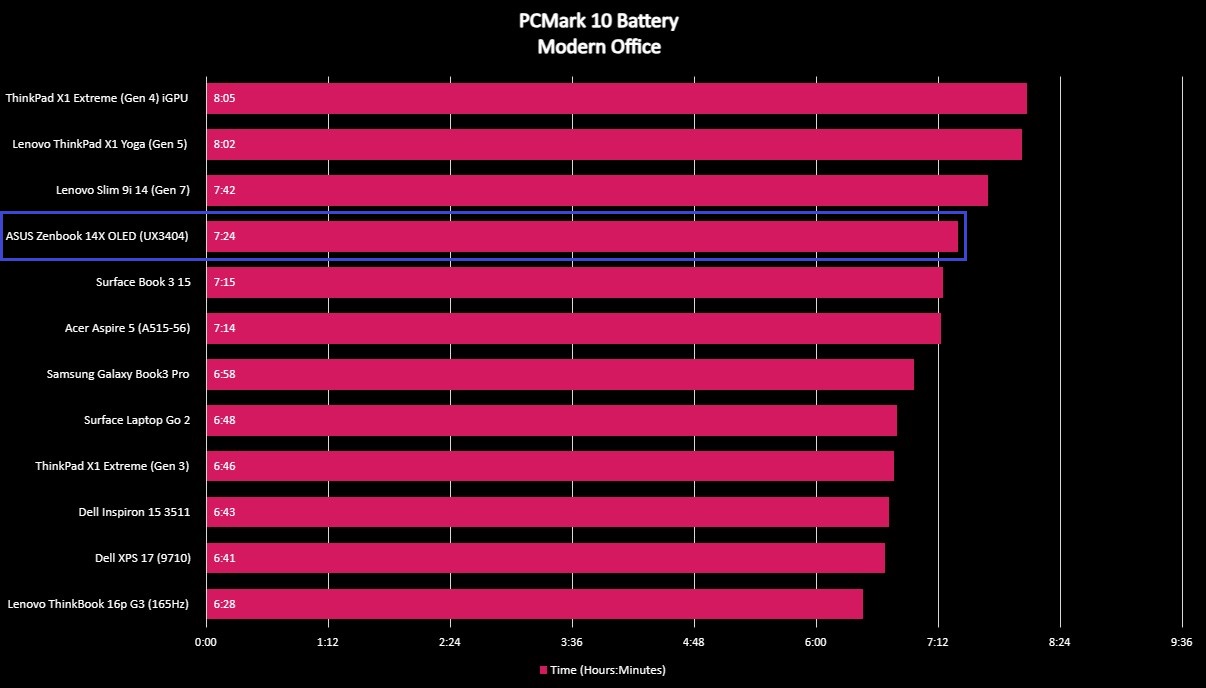
I'm a firm believer in keeping default settings on with these kinds of tests, which means the Zenbook 14X OLED was at a comfortable 70% display brightness with its keyboard backlight enabled and set to the Standard/Balanced power profile. If you lower the screen brightness, disable the keyboard backlight with the press of a function key, and set the laptop to the Quiet/Best efficiency power profile, you can definitely squeeze out a decent chunk of more life. In the above test, the display was set to 60Hz, as the default for this laptop is to lower the refresh rate when away from the charger.
Generating a Windows Battery Report returns similar results of 6 hours and 58 minutes of expected battery life. You can kill the laptop much faster if you stress the hardware and ramp up the settings, but a reasonable workload spread across an entire day sees the Zenbook 14X OLED run around seven solid hours before tapping out. That's just enough for me not to be stressed when taking the laptop out for the day, and it's more than I honestly expected from this hardware. The 100W USB Type-C charger keeps things topped off effortlessly from either Thunderbolt 4 port and has the added convenience of being, you know, a universal Type-C charger.
Zenbook 14X OLED review: Everything else

The leftovers highlights
- The keyboard is comfortable and spacious, and the touchpad is smooth and responsive.
- The front-facing camera isn't industry-leading but is more than enough for video conferencing, as are the dual microphones.
- Windows 11 runs flawlessly, with the MyASUS app being a solid hub for managing the laptop.
Alright, we've covered all the biggest categories. Let's wrap this up with a quick rundown of what I'm now calling the leftovers! The keyboard on the ASUS Zenbook 14X OLED is spacious and quite comfortable to type on. It's a little on the soft side, and the backlighting isn't as consistently smooth as on other laptops, but it's still a great keyboard. The function row at the top has all the quick controls you need, and it's easy to toggle the regular function keys when needed. The touchpad is fantastic, with a smooth glass texture, responsive movement and gestures, and a built-in number pad you can toggle at will (this numpad can be a little difficult to learn how to use, but it's still great to have on a 14-inch laptop).
The dual stereo speakers do support Dolby Atmos and actually sound pretty great at low-to-mid volumes, even for complex music (although it is a little hollow-sounding). There's more low-end than I expected, the max volume is dramatically high, and there's little audio distortion until you reach those higher volumes. The front-facing camera isn't anything special, but it is detailed at FHD, accurately reproduces colors, and performs well in varied lighting conditions, making it great for video conferences when combined with dual-array microphones. An IR sensor nets you Windows Hello biometric authentication, which was always incredibly fast and reliable for signing me in.
Wireless connectivity is top-notch with Wi-Fi 6E and Bluetooth 5.3, and performance was flawless. The same can be said of Windows 11, which consistently ran great on this laptop (better than on some significantly more powerful gaming laptops I've tested). There is a handful of preinstalled apps and programs, but nothing too egregious or invasive (except for McAfee — get that out of here). MyASUS is a solid hub for customizing the Zenbook 14X OLED's settings and hardware, with reliable performance and stability, but the interface is a little hectic and confusing.
Zenbook 14X OLED review: Competition
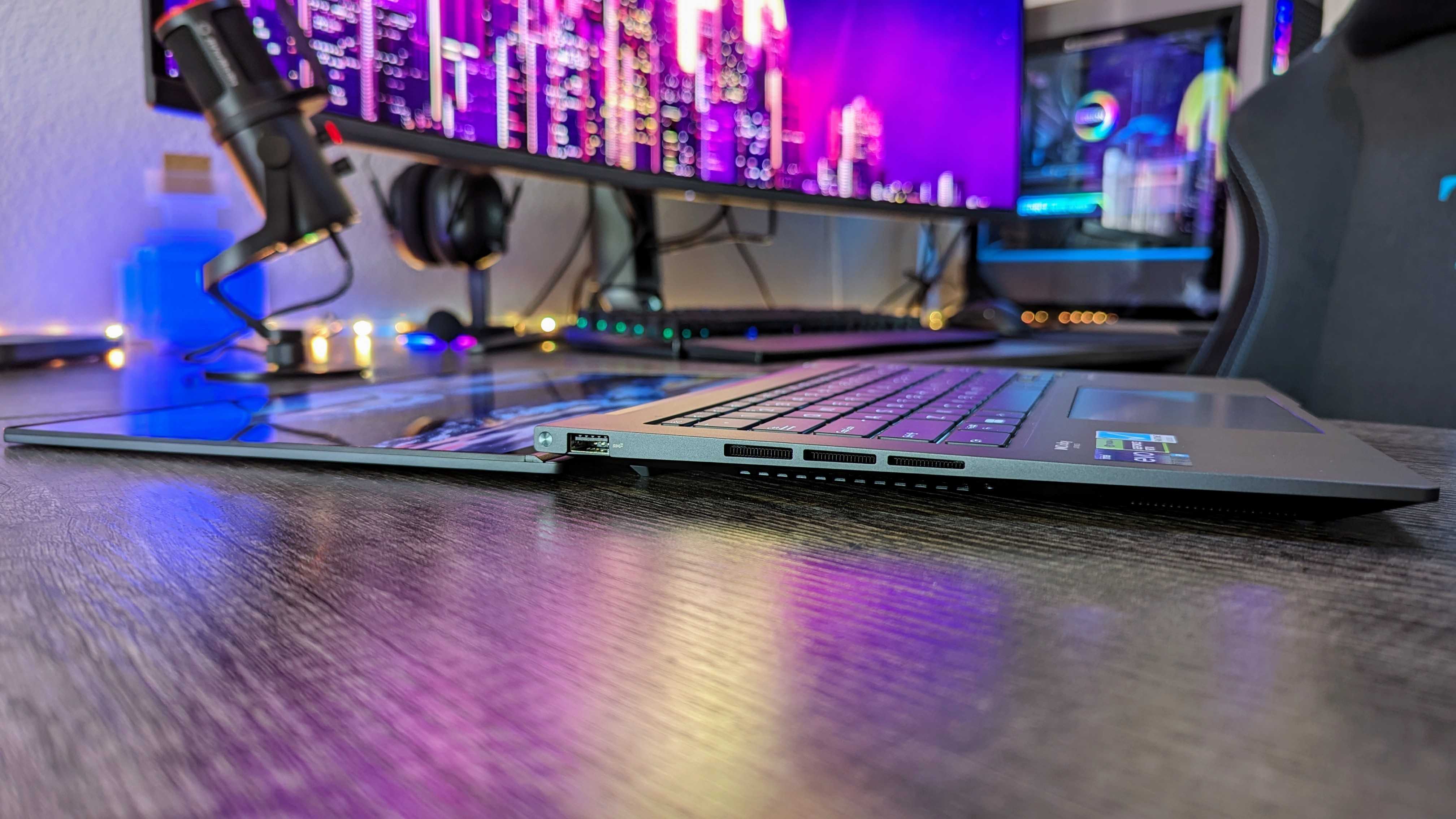
It's difficult enough to pull off a compact laptop with the power of a large laptop that most companies don't make an effort to the same degree as ASUS did with the Zenbook 14X OLED, especially not at this price point. For a pure ultrabook, the Lenovo Yoga 9i is wonderful but not as powerful. For a more versatile convertible, the Surface Laptop Studio 2 is just as powerful but significantly more expensive. For a larger, more traditional laptop, the Dell XPS 15 (9530) is just as powerful but is also more expensive in the configurations that compete with the Zenbook 14X OLED.
You can even consider the lower-end version of this laptop, the regular ASUS Zenbook 14 OLED (UM3402), which costs a whole lot less and still boasts that incredible OLED display (and much better battery life). You're losing a lot of power and creator-focused features, though. That gap may become smaller with the new Intel Ultra-powered ASUS Zenbook 14 OLED; until then, the Zenbook 14X OLED (UX3404) strikes an interesting compromise between form factor, features, and price, making it a very strong competitor for the best Windows laptops.
Zenbook 14X OLED review: Final thoughts
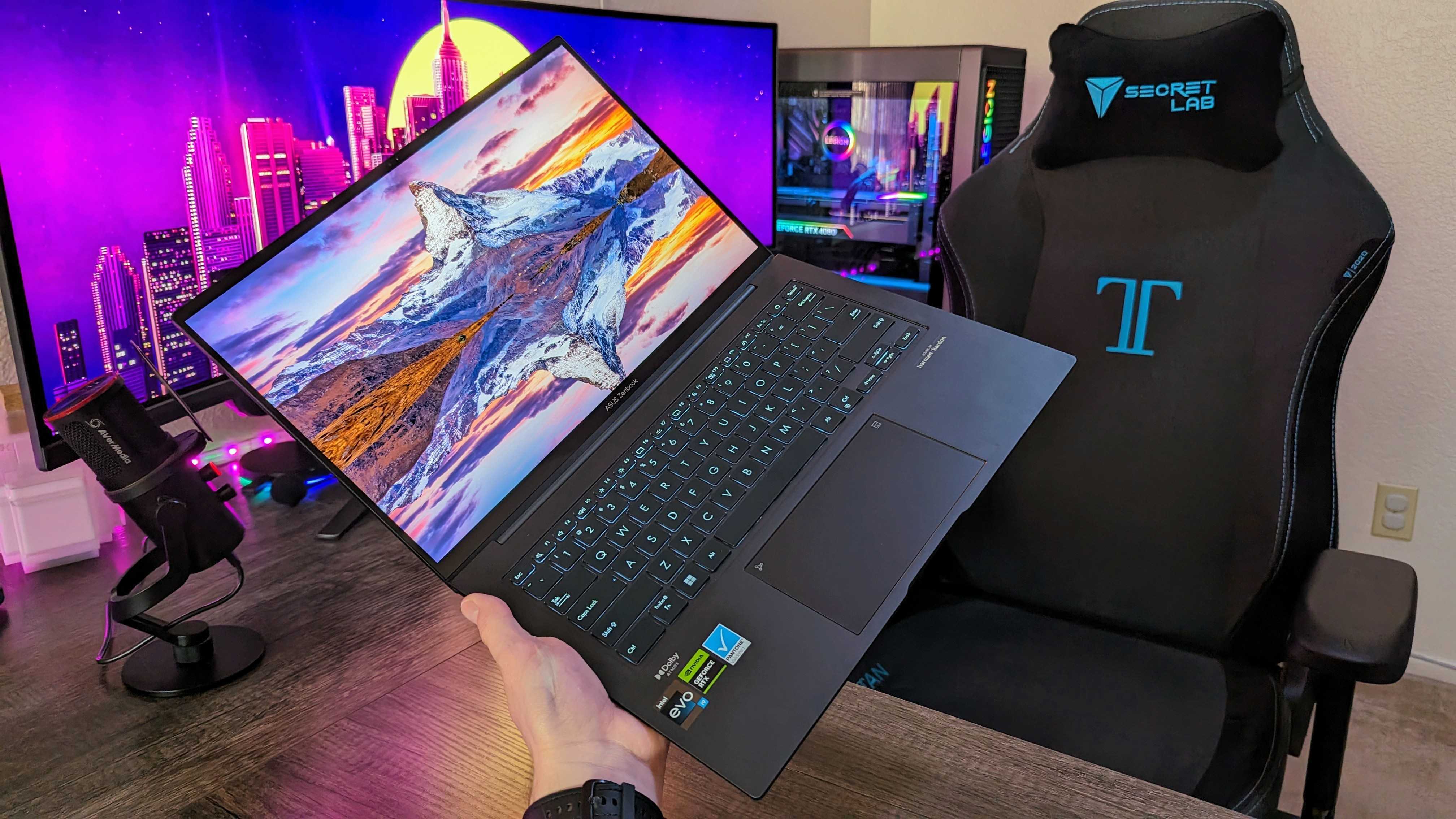
You should buy this if ...
You should not buy this if ...
I don't want to be done with this review because I don't want to be done with the ASUS Zenbook 14X OLED. I've loved my time with this laptop, and I've been so impressed by its blend of reliable performance, consistent battery endurance, industry-leading display, premium and compact design, and reasonable price tag that it has actually made me less eager for the arrival of Intel Ultra-powered Windows laptops.
Don't get me wrong, I'm still very interested to see what the next generation of Intel-powered Windows laptops brings to the table, but the ASUS Zenbook 14X OLED (UX3404) is good enough right now that you might not have to wait. That'll be especially true if ASUS ends up discounting this laptop when Intel Ultra PCs begin arriving, making it an ever better deal for the incredibly well-rounded package you get. The Zenbook 14X OLED doesn't get anything major wrong, and it gets so much right. This is a top-notch 14-inch laptop.
For $1,499.99, you can get an excellent 14-inch Windows laptop packing a ton of power and one of the best displays you'll find in any laptop, let alone in this price range. The Zenbook 14X OLED is a very balanced clamshell with no major flaws, and it's one of my favorite Windows laptops you can buy today — and maybe even in the future when Intel Ultra arrives.







